
Corydoras is a genus of freshwater catfish in the family Callichthyidae and subfamily Corydoradinae. The species usually have more restricted areas of endemism than other callichthyids, but the area of distribution of the entire genus almost equals the area of distribution of the family, except for Panama where Corydoras is not present. Corydoras species are distributed in South America where found east of the Andes to the Atlantic coast, from Trinidad to the Río de la Plata drainage in northern Argentina. Species assigned to Corydoras display a broad diversity of body shapes and coloration. Corydoras are small fish, ranging from 2.5 to 12 cm in SL., and are protected from predators by their body armor and by their sharp, typically venomous spines.

The bronze corydoras, green corydoras, bronze catfish, lightspot corydoras or wavy catfish is a tropical freshwater fish in the "armored catfish" family, Callichthyidae, often kept in captivity by fish keepers. It is widely distributed in South America on the eastern side of the Andes, from Colombia and Trinidad to the Río de la Plata basin. It was originally described as Hoplosoma aeneum by Theodore Gill in 1858 and has also been referred to as Callichthys aeneus.
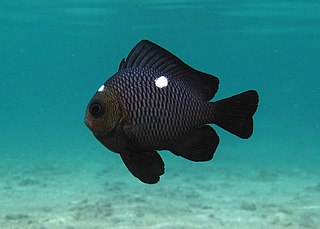
Dascyllus is a genus of fish in the family Pomacentridae. They are usually commensals with corals.
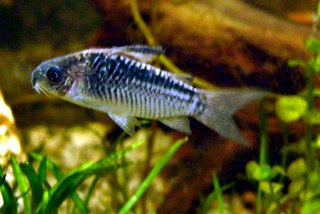
The elegant corydoras or elegant catfish is a tropical freshwater fish belonging to the subfamily Corydoradinae of the family Callichthyidae. It originates in inland waters in South America, and is found in the Upper Amazon River basin in Brazil, Colombia and Peru. The specific epithet elegans means elegant.
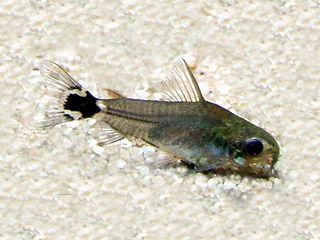
The dwarf corydoras, dwarf catfish, tail spot pygmy catfish, or micro catfish is a tropical freshwater fish belonging to the subfamily Corydoradinae of the family Callichthyidae. It originates in inland waters in South America, and is found in the Amazon River and Paraguay River basins in Argentina, Bolivia, and Brazil. The specific epithet hastatus means with a spear, in reference to the spearhead-like spot on the tail root.
Corydoras nanus is a tropical freshwater fish belonging to the Corydoradinae sub-family of the family Callichthyidae. It originates in inland waters in South America, and is found in the Suriname and Maroni River basins in Suriname and the Iracoubo River basin in French Guiana.
Corydoras narcissus is a tropical freshwater fish belonging to the Corydoradinae sub-family of the family Callichthyidae. It originates in inland waters in South America, and is found in the Purus River in the central Amazon Basin in Brazil. It is commonly known as the Long Nose Arched Cory. These fish are identifiable by the two dark stripes that run alongside their dorsal fins.

The blue corydoras or Natterer's catfish is a tropical freshwater fish belonging to the subfamily Corydoradinae of the family Callichthyidae. It originates in coastal rivers in South America, and is found in the Brazil from Espírito Santo to Paraná. It is named for Johann Natterer, its discoverer.
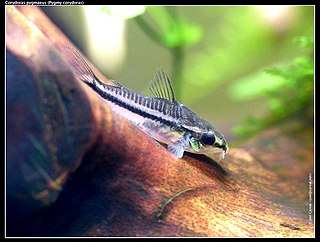
The pygmy corydoras or pygmy catfish is a tropical and freshwater fish belonging to the subfamily Corydoradinae of the family Callichthyidae. It originates in tropical inland waters in South America, and is found in the Madeira River basin in Brazil.
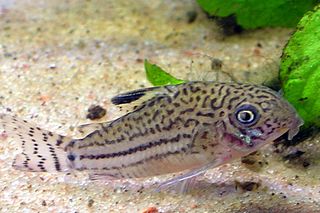
The three stripe corydoras, leopard catfish, false julii corydoras, or three line catfish is a tropical freshwater fish belonging to the subfamily Corydoradinae of the family Callichthyidae. It originates in inland waters in South America, and is found in the central Amazon River basin in Brazil and Colombia, Peruvian Amazon and coastal rivers in Suriname.
The golden otocinclus is one of the smallest known suckermouth catfish, often called a 'dwarf oto'. Endemic to Southeast Brazil, this herbivorous, rheophilic, bottom-feeder only grows to around 4 cm (1.6 in) in length. The close relatives of this small fish are often used for the purpose of controlling algae in small home aquariums, under the name Otocinclus affinis. In reality, they belong to the species O. vittatus, O. vestitus and O. macrospilus. The real O. affinis is not present in the aquarium hobby.

Corydoras julii is a small freshwater catfish native to eastern Brazil. It is a popular aquarium fish.

Dascyllus aruanus, known commonly as the whitetail dascyllus or humbug damselfish among other vernacular names, is a species of marine fish in the family Pomacentridae.

The threespot dascyllus, also known as the domino damsel or simply domino, is a species of damselfish from the family Pomacentridae. It is native to the Indo-Pacific from the Red Sea and East Africa, to the Pitcairn Islands, southern Japan, and Australia. Its grey to black body has two lateral white spots and one between the eyes like domino hence the name; the threespot dascyllus grows up to 13 cm in length. Coloration is somewhat variable; the spot on the forehead may be absent and the lateral spots very much reduced. It feeds on algae, copepods and other planktonic crustaceans.

The nosestripe clownfish or nosestripe anemonefish, skunk clownfish, Amphiprion akallopisos, is an anemonefish that lives in association with sea anemones. A. akallopisos is found in the Indian Ocean. It resides in shallow inshore reefs as deep as 15 m with a moderate to strong current. The skunk clownfish can also be kept in captivity by aquarists.

Dascyllus melanurus, known commonly as the four stripe damselfish, blacktail dascyllus, humbug damselfish, blacktail damselfish, and blacktail humbug, is a species of fish in the family Pomacentridae. It is native to the western Pacific Ocean. It is sometimes kept as an aquarium pet.

Dascyllus reticulatus, known commonly as the reticulate dascyllus or two-stripe damselfish among other vernacular names, is a species of marine fish in the family Pomacentridae.
Han Nijssen was a Dutch ichthyologist.















